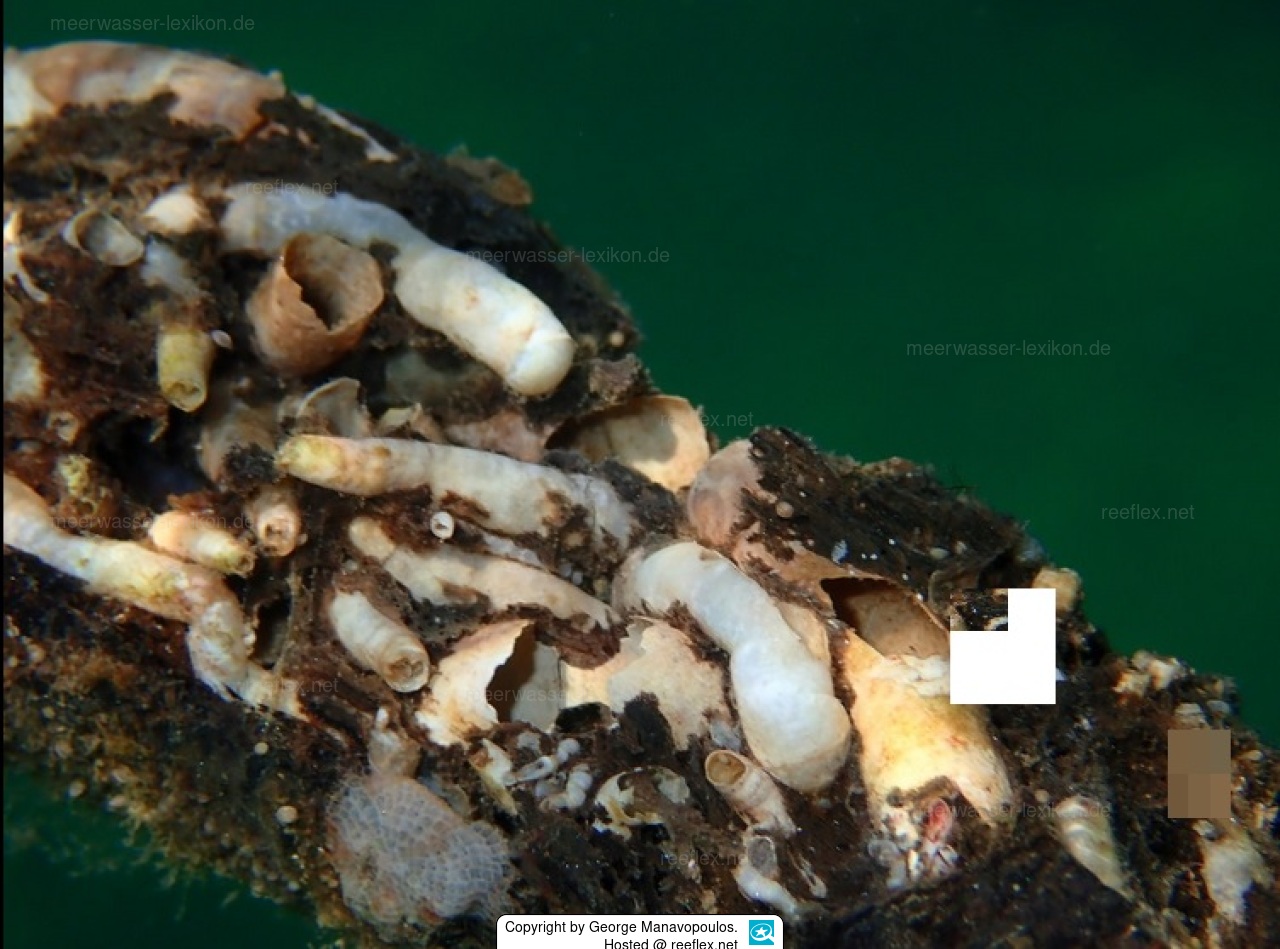Info
Despite its colloquial name, the shipworm Teredo navalis is not a worm, but a bivalve from the family of ship bivalves (Teredinidae).
The body of shipworms/ship bivalves is worm-like elongated and soft .The shell is equally lobed, semi-spherical and grows to only about 1 cm in size. In it, the bivalve shells have greatly reduced in size and remodeled as drilling tools.
Teredo navalis itself reaches up to 50 cm in length , but usually remains smaller at about 10-20 cm. Its usual size is often compared with the size of a pencil. The shells cover only the front part of the soft body and are used for scraping the wood.
The mantle of the elongated body secretes a calcareous tube about 1 cm in diameter, which serves as a living tube for the shipworm and lines the drilled tube.
The shipworm lives in warm and temperate zones worldwide. They are and have been carried around the world by shipping on wooden ships. It is salinity tolerant, surviving even short freshwater phases by sealing its living tube with limestone plates. Furthermore, these worms survive large temperature differences from 0 to 30° C.
Ship borers are protandrous hermaphrodites that can change sex several times in their life. Their veliger larvae live planktonic.Teredo navalis lives up to 3 years.
Shipworms are known for sometimes extensive damage to wooden ships, wooden port facilities, bridges and jetties from maritime history.
Teredo navalis is distributed worldwide and is the worst destroyer among the marine borers.
On the other hand, they contribute to the removal of driftwood.
Because of their wood-decomposing lifestyle, shipworms are often called "termites of the seas".
Very special thanks for the first great photos of Teredo navalis to George Manavopoulos, Greece!!!
Synonyms:
Pholas teredo O. F. Müller, 1776
Serpula teredo DaCosta, 1778
Teredo austini Iredale, 1932
Teredo batavus Spengler, 1792
Teredo beachi Bartsch, 1921
Teredo beaufortana Bartsch, 1922
Teredo japonica Clessin, 1893
Teredo marina Jeffreys, 1860
Teredo morsei Bartsch, 1922
Teredo navalis borealis Roch, 1931
Teredo navalis var. occlusa Jeffreys, 1865
Teredo novangliae Bartsch, 1922
Teredo pocilliformis Roch, 1931
Teredo sellii van der Hoeven, 1850
Teredo sinensis Roch, 1929
Teredo vulgaris Lamarck, 1801
The body of shipworms/ship bivalves is worm-like elongated and soft .The shell is equally lobed, semi-spherical and grows to only about 1 cm in size. In it, the bivalve shells have greatly reduced in size and remodeled as drilling tools.
Teredo navalis itself reaches up to 50 cm in length , but usually remains smaller at about 10-20 cm. Its usual size is often compared with the size of a pencil. The shells cover only the front part of the soft body and are used for scraping the wood.
The mantle of the elongated body secretes a calcareous tube about 1 cm in diameter, which serves as a living tube for the shipworm and lines the drilled tube.
The shipworm lives in warm and temperate zones worldwide. They are and have been carried around the world by shipping on wooden ships. It is salinity tolerant, surviving even short freshwater phases by sealing its living tube with limestone plates. Furthermore, these worms survive large temperature differences from 0 to 30° C.
Ship borers are protandrous hermaphrodites that can change sex several times in their life. Their veliger larvae live planktonic.Teredo navalis lives up to 3 years.
Shipworms are known for sometimes extensive damage to wooden ships, wooden port facilities, bridges and jetties from maritime history.
Teredo navalis is distributed worldwide and is the worst destroyer among the marine borers.
On the other hand, they contribute to the removal of driftwood.
Because of their wood-decomposing lifestyle, shipworms are often called "termites of the seas".
Very special thanks for the first great photos of Teredo navalis to George Manavopoulos, Greece!!!
Synonyms:
Pholas teredo O. F. Müller, 1776
Serpula teredo DaCosta, 1778
Teredo austini Iredale, 1932
Teredo batavus Spengler, 1792
Teredo beachi Bartsch, 1921
Teredo beaufortana Bartsch, 1922
Teredo japonica Clessin, 1893
Teredo marina Jeffreys, 1860
Teredo morsei Bartsch, 1922
Teredo navalis borealis Roch, 1931
Teredo navalis var. occlusa Jeffreys, 1865
Teredo novangliae Bartsch, 1922
Teredo pocilliformis Roch, 1931
Teredo sellii van der Hoeven, 1850
Teredo sinensis Roch, 1929
Teredo vulgaris Lamarck, 1801







 George Manavopoulos, Griechenland
George Manavopoulos, Griechenland


